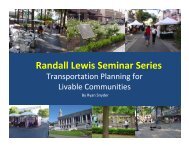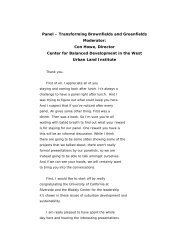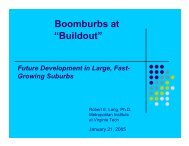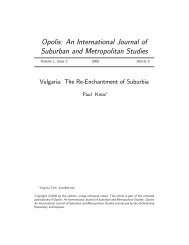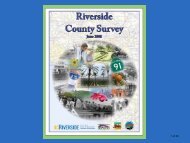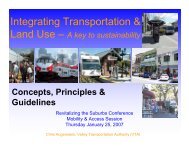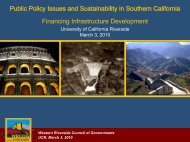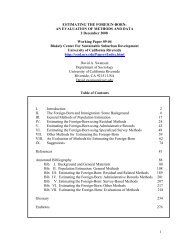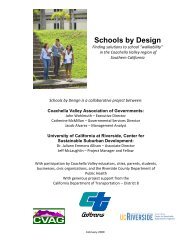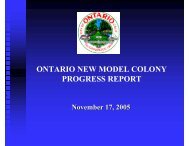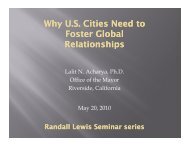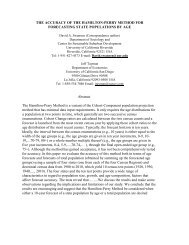Latino New Urbanism: Building on Cultural Preferences - Center for ...
Latino New Urbanism: Building on Cultural Preferences - Center for ...
Latino New Urbanism: Building on Cultural Preferences - Center for ...
Create successful ePaper yourself
Turn your PDF publications into a flip-book with our unique Google optimized e-Paper software.
Urbanist developments, in that the<br />
porch invites neighbors to gather.<br />
In <str<strong>on</strong>g>New</str<strong>on</strong>g> Urbanist developments,<br />
porches are a hub <strong>for</strong> social leisure<br />
activities. According to Daria Price<br />
Bowman (1997), the porch is a neutral<br />
territory that provides a natural link to<br />
the neighborhood. In <str<strong>on</strong>g>New</str<strong>on</strong>g> <str<strong>on</strong>g>Urbanism</str<strong>on</strong>g><br />
and the East Los Angeles vernacular<br />
(coupled with the use of the driveway),<br />
the porch is used to increase living and<br />
entertaining opti<strong>on</strong>s (Bowman 1997).<br />
Latinizati<strong>on</strong> of Parks and Public Space<br />
The appropriati<strong>on</strong> of park spaces to<br />
facilitate social activities provides<br />
another example of how <str<strong>on</strong>g>Latino</str<strong>on</strong>g>s adapt<br />
the built envir<strong>on</strong>ment to meet their<br />
physical and social needs.<br />
There is an obvious carryover from<br />
Latin America to the United States of<br />
the preference <strong>for</strong> parks and plazas to<br />
serve as the core social setting of a<br />
community or city. Academic work has<br />
acknowledged the importance of<br />
plazas and parks (public spaces) <strong>for</strong><br />
Mexicans and Mexican-Americans.<br />
Social historian Charles Flaundrau,<br />
awed by the significance of plazas and<br />
parks in Mexico, wrote<br />
There are city parks and<br />
squares in other countries, but<br />
in n<strong>on</strong>e do they play the same<br />
intimate and important part in<br />
the nati<strong>on</strong>al domestic life that<br />
they do in Mexico ...the Plaza is<br />
in c<strong>on</strong>stant use from morning<br />
until late at night ...by eleven<br />
o’clock the whole town will, at<br />
various hours, have passed<br />
through it, strolled in it, played,<br />
Mendez: <str<strong>on</strong>g>Latino</str<strong>on</strong>g> <str<strong>on</strong>g>New</str<strong>on</strong>g> <str<strong>on</strong>g>Urbanism</str<strong>on</strong>g><br />
sat, rested, or thought in it<br />
(Flaundrau 1964).<br />
37<br />
As a result, the US park serves as<br />
<str<strong>on</strong>g>Latino</str<strong>on</strong>g>s’ primary social space outside<br />
the home. The neighborhood park’s<br />
usefulness <strong>for</strong> social interacti<strong>on</strong> offers<br />
a surrogate <strong>for</strong> the misplaced plaza<br />
and meets the objectives of many <str<strong>on</strong>g>New</str<strong>on</strong>g><br />
Urbanist developments. <str<strong>on</strong>g>New</str<strong>on</strong>g><br />
<str<strong>on</strong>g>Urbanism</str<strong>on</strong>g> attempts to create a greater<br />
sense of community by rethinking the<br />
“public realm,” especially public spaces<br />
and recreati<strong>on</strong>al facilities. The<br />
C<strong>on</strong>gress of the <str<strong>on</strong>g>New</str<strong>on</strong>g> <str<strong>on</strong>g>Urbanism</str<strong>on</strong>g>, the<br />
leading organizati<strong>on</strong> <strong>for</strong> the movement,<br />
believes cities and towns should be<br />
shaped by physically defined and<br />
universally accessible public spaces,<br />
and community instituti<strong>on</strong>s (Fult<strong>on</strong>,<br />
1996).<br />
Extensive survey work <strong>on</strong> park usage<br />
am<strong>on</strong>g different ethnic and racial<br />
groups in four metropolitan Los<br />
Angeles parks shows that <str<strong>on</strong>g>Latino</str<strong>on</strong>g>s are<br />
the most active and frequent users<br />
(Loukaitou-Sideris 1995). The survey<br />
found that <str<strong>on</strong>g>Latino</str<strong>on</strong>g>s at parks were<br />
involved in sociable activities including<br />
parties, picnics, and celebrati<strong>on</strong>s of<br />
birthdays, baptism, and communi<strong>on</strong>s.<br />
Their group behavior involved talking<br />
while sitting or standing, eating,<br />
breaking piñatas, playing sports, and<br />
keeping an eye <strong>on</strong> their children. This<br />
is a great c<strong>on</strong>trast to Anglos, who<br />
primarily participated in mobile, solitary<br />
activities such as jogging, walking,<br />
bicycling, or dog walking. The study<br />
c<strong>on</strong>cluded that Anglos valued the park<br />
more <strong>for</strong> its aesthetic qualities and<br />
natural elements while <str<strong>on</strong>g>Latino</str<strong>on</strong>g>s valued<br />
its opportunities <strong>for</strong> social interacti<strong>on</strong>.<br />
<str<strong>on</strong>g>Latino</str<strong>on</strong>g>s also were more likely than<br />
other racial and ethnic groups to



